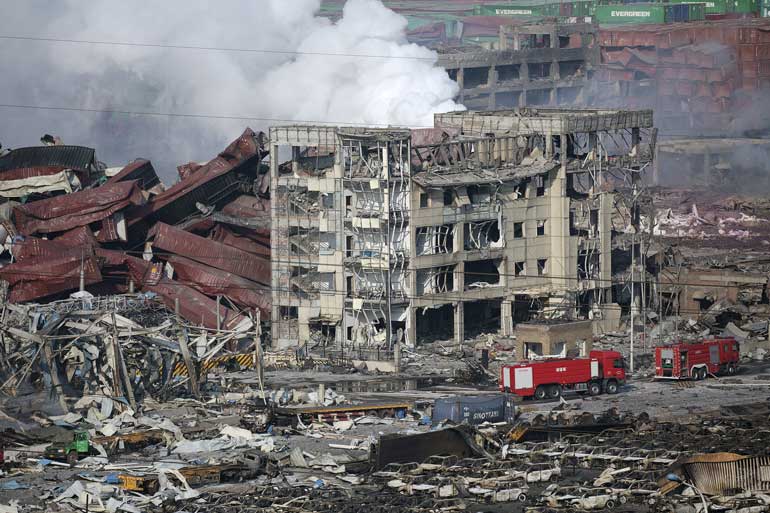Monday Dec 29, 2025
Monday Dec 29, 2025
Saturday, 15 August 2015 00:03 - - {{hitsCtrl.values.hits}}
 Fire engines are seen at the site of the explosions at the Binhai new district, Tianjin, August 13, 2015 - REUTERS
Fire engines are seen at the site of the explosions at the Binhai new district, Tianjin, August 13, 2015 - REUTERS
Reuters: A senior Chinese official defended fire fighters who initially hosed water on a blaze in a warehouse in northeast China where volatile chemicals were stored, a response foreign experts said could have contributed to two huge blasts that killed 54 people.
More than a dozen firefighters were among those killed by the massive explosions at the busy port in Tianjin city on Wednesday night, state media said. About 700 people were injured, 71 seriously.
Columns of smoke from fires still burning on Friday rose from the blast site amid the devastation of crumpled shipping containers, thousands of torched cars and port buildings reduced to burnt-out shells. Rescuers pulled one survivor, from the wreckage, a city official told reporters. State television later said it was a firefighter.
The warehouse, designed to house dangerous and toxic chemicals, was storing mainly ammonium nitrate, potassium nitrate and calcium carbide at the time of the blasts, according to police. The official Xinhua news agency has said several containers in the warehouse caught fire before the explosions.
Chemical safety experts said calcium carbide reacts with water to create acetylene, a highly explosive gas. An explosion could be caused if fire fighters sprayed the calcium carbide with water, they said.
Lei Jinde, the deputy propaganda department head of China’s fire department, a part of the Ministry of Public Security, told state-backed news website ThePaper.cn that the first group of fire fighters on the scene had used water.
“We knew there was calcium carbide inside but we didn’t know whether it had already exploded,” he said.
“At that point no one knew, it wasn’t that the fire fighters were stupid,” Lei said, adding that it was a large warehouse and they didn’t know the exact location of the calcium carbide.
CCTV reported that another four firefighters were confirmed dead and 13 were still missing. Xinhua said earlier that 66 firefighters were among the hundreds of people hospitalised.
David Leggett, a chemical safety expert based in California, told Reuters the acetylene explosion could have detonated the ammonium nitrate. The two blasts were about 30 seconds apart, the second much larger than the first.
“In my mind, the presence of ammonium nitrate makes it easier to explain the level of devastation,” he said.
Stuart Prescott, a senior lecturer in chemical engineering at the University of New South Wales in Australia, said water was recommended to extinguish the two nitrates but a chemical powder was needed for calcium carbide.
“Calcium carbide reacts with the water and that’s a reasonably violent reaction in and of itself, because it releases gas. The gas itself is also flammable,” he said.
The explosions at the port, the world’s 10th largest, were so big they were seen by satellites in space and registered on earthquake sensors.
Several thousand residents were moved to 10 nearby schools after apartment buildings and homes were damaged, mainly by shockwaves from the explosions, it said.
Foreign companies from across the globe were trying to determine the damage to their facilities in and around the port, a gateway to northeast China.
French carmaker Renault said its warehouse at the port sustained severe damage and nearly 1,500 of its cars stored there were burned, according to early estimates.
Several Japanese automakers including Toyota Motor Corp reported minor damage to cars and facilities.
Mining giant BHP Billiton said its port operations and shipments were disrupted but its iron ore discharging berth had not been damaged.